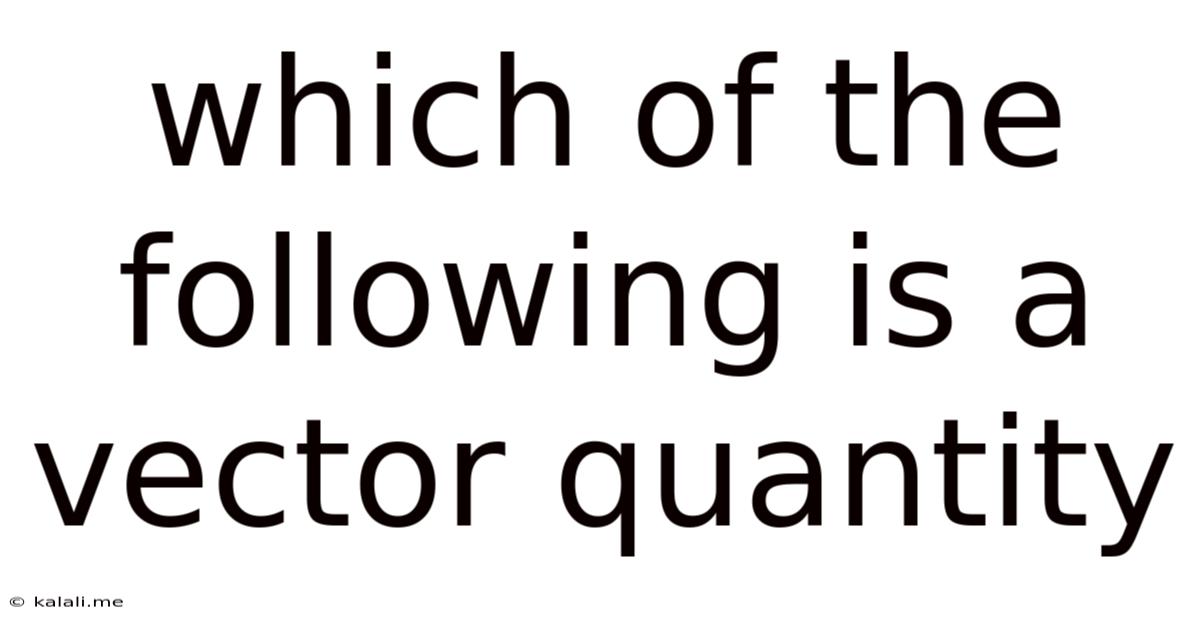Which Of The Following Is A Vector Quantity
Kalali
Jun 11, 2025 · 2 min read

Table of Contents
Which of the Following is a Vector Quantity? Understanding Vectors and Scalars
This article will delve into the crucial difference between scalar and vector quantities, ultimately answering the question: which of the following is a vector quantity? We'll explore the defining characteristics of vectors, providing clear examples to solidify your understanding. Understanding this distinction is fundamental in physics and many other scientific fields.
What are Scalar and Vector Quantities?
Before we identify a vector quantity from a list (which will be addressed later in the article), let's clarify the definitions:
-
Scalar Quantities: These quantities are fully described by a single number (magnitude) and a unit. They only have size or amount. Think of things like temperature (25°C), mass (5 kg), speed (10 m/s), or time (3 hours). They don't have a direction associated with them.
-
Vector Quantities: These quantities require both magnitude and direction to be fully described. Examples include displacement (5 meters north), velocity (20 m/s east), force (10 N upwards), acceleration (9.8 m/s² downwards), and momentum. The direction is an integral part of their definition.
Key Differences Summarized:
| Feature | Scalar Quantity | Vector Quantity |
|---|---|---|
| Magnitude | Only magnitude is needed | Magnitude and direction needed |
| Direction | No direction | Direction is crucial |
| Representation | Single number and unit | Arrow (length represents magnitude, direction shows direction) |
| Examples | Mass, speed, temperature | Velocity, force, acceleration |
Identifying a Vector Quantity: A Practical Approach
Let's say you're presented with a list of quantities: speed, velocity, force, mass, temperature, and acceleration. To determine which are vectors, ask yourself: Does this quantity have a direction associated with it?
-
Speed: This is a scalar. It tells you how fast something is moving but not where it's moving.
-
Velocity: This is a vector. It tells you both how fast something is moving and in what direction. For example, 20 m/s east is a velocity.
-
Force: This is a vector. A force of 10N acting upwards is different from a force of 10N acting downwards.
-
Mass: This is a scalar. It only represents the amount of matter.
-
Temperature: This is a scalar. It simply represents the hotness or coldness of an object.
-
Acceleration: This is a vector. Acceleration is the rate of change of velocity, and since velocity is a vector, acceleration must also be a vector. It has both magnitude and direction.
In Conclusion:
From the example list, velocity, force, and acceleration are vector quantities because they require both magnitude and direction for complete description. Understanding the difference between scalars and vectors is vital for a proper grasp of physics and other related scientific disciplines. Remembering the need for both magnitude and direction is the key to identifying vector quantities. Always consider the directional component when evaluating any physical quantity.
Latest Posts
Latest Posts
-
How Many Pounds Is A Bushel Of Peanuts
Jul 01, 2025
-
How Many Pounds Are In 32 Ounces
Jul 01, 2025
-
What Year Would I Be Born If I Was 21
Jul 01, 2025
-
How Many Minutes Are In 40 Hours
Jul 01, 2025
-
How Many Cups Are In 16 Oz Of Sour Cream
Jul 01, 2025
Related Post
Thank you for visiting our website which covers about Which Of The Following Is A Vector Quantity . We hope the information provided has been useful to you. Feel free to contact us if you have any questions or need further assistance. See you next time and don't miss to bookmark.